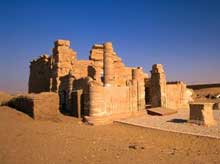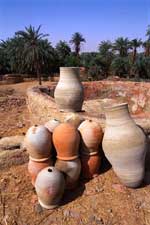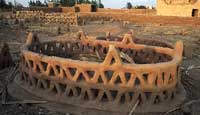|
The Dakhla Oasis
lies to the northwest of Kharga and is also about 310 km to the
southeast of Farafra. This oasis consists of 14 settlements and
has a population of about 70,000 people. Dakhla is the farthest
oasis out of Cairo and is considered one of Egypt's most
beautiful oases.
 Dakhla sits in a depression surrounded by pink cliffs. There are
about 30,000 acres of cultivated land. Most of its 70,000 or so
residents are farmers who constantly fight the battle of the
dunes that threaten their fields and orchards. The fields and
gardens are filled mostly with mulberry trees, date palms, figs
and other citrus fruits. Dakhla has retained most of its culture
and charm even though it has increased in size by about double
and government funding and technical training has revitalized
the economy. Dakhla is the only place in Egypt where new water
wheels which are driven by buffaloes are constructed. They are
made of palm timber and clay jars and are called saqiyas. The
oasis is connected to Kharga by a 120 mile (200 km) road that
has buses running daily. Dakhla sits in a depression surrounded by pink cliffs. There are
about 30,000 acres of cultivated land. Most of its 70,000 or so
residents are farmers who constantly fight the battle of the
dunes that threaten their fields and orchards. The fields and
gardens are filled mostly with mulberry trees, date palms, figs
and other citrus fruits. Dakhla has retained most of its culture
and charm even though it has increased in size by about double
and government funding and technical training has revitalized
the economy. Dakhla is the only place in Egypt where new water
wheels which are driven by buffaloes are constructed. They are
made of palm timber and clay jars and are called saqiyas. The
oasis is connected to Kharga by a 120 mile (200 km) road that
has buses running daily.
Research has found that the Oasis has been inhabited since
prehistoric times, and that there was once a huge lake here.
There are neolithic rock paintings that indicate that the lake
was frequented by elephants, buffaloes and ostriches. As the
lake dried up, the inhabitants migrated to the Nile valley and
were probably some of its first settlers.
Dakhla Oasis is dominated on its northern horizon by a wall of
rose-Colored rock. Fertile cultivated areas growing rice,
peanuts and fruit are dotted between sand dunes along the roads
from Farafra and Kharga in this area of outstanding natural
beauty. The capital, Mut, named after the ancient goddess of the
Theban Triad, houses the Museum of the Inheritance, a
traditional house, with an intricate wooden combination lock.
Rooms, with sculpted clay figures, are arranged to show
different aspects of Dakhlan culture and family life. Mut is
probably the most "tourist friendly" village in the Dakhla Oasis
and does have some accommodations and amenities in that regard,
including a number of hot sulphur pools. It has winding streets
around old mud-brick houses, and there is an old citadel which
is the remains of the old town. There is also a medieval Islamic
cemetery on the outskirts of the village.
 Al-Kasr, about 35 km. from Mut, was originally a Roman
settlement which later became the medieval capital of Dakhla.
The old town is a labyrinth of mud-walled alleys narrowly
separating houses with elaborately- carved wooden lintels. It is
little changed from medieval times. With a population of around
700, the town was built from the it's Roman ruins and has narrow
covered streets. There are 54 lintels, some dating from the
Ottoman and Mamluk era which adorn the old houses, one of which
dates to about 924 AD. Al-Kasr, about 35 km. from Mut, was originally a Roman
settlement which later became the medieval capital of Dakhla.
The old town is a labyrinth of mud-walled alleys narrowly
separating houses with elaborately- carved wooden lintels. It is
little changed from medieval times. With a population of around
700, the town was built from the it's Roman ruins and has narrow
covered streets. There are 54 lintels, some dating from the
Ottoman and Mamluk era which adorn the old houses, one of which
dates to about 924 AD.
There is also an Ayyubid mosque. It has a three-story mud-brick
minaret, 21 meters high, and wooden lintels decorated with
inscriptions from the Koran at the entrances. The local madrassa
has been renovated, along with an old house which are open to
tourists. Climb to the rooftop of the 10th century madrassa
(school) for wonderful views of the surrounding area. Bir
al-Gabel, a palm-fringed salt lake where you can camp and
picnic, is on the road back to Mut.
Other local sites of interest include a pottery factory and an
old corn mill. Mud bricks are still made in an ancient manner
and there is a foundry where men still work mettle using bellows
flamed fires.
Other day trips from Mut could include the 1st-century al-Muzawaka
tombs and Deir al
Hagar. Al Muzawaka tombs are located 35 km away, they date back
to the Pharaonic period. The most important are the rock hewn
tombs of Pelusis and Petosiris. While the tombs are decorated in
traditional Egyptian fashion, Petosiris is dressed as a Greek,
and there is a bull on the ceiling from the Persian Mithras
cult.
Deir El hagar (Monastery of the Rock) a temple which was
originally dedicated to Amun and his wife Mut and has
inscriptions representing religious life. It was later rebuilt
by the Romans and it is one of the few Roman ruins in the area.
It has been damaged by an earthquake but is said to have been
recently restored. It was built during the rule of Nero (45-68
AD).
 After exploring the temple, bathe in the hot sulphur spring
nearby. Visit Bashendi to After exploring the temple, bathe in the hot sulphur spring
nearby. Visit Bashendi to
see Roman tombs and a factory where carpets are still woven with
scenes of Dakhlan life. Bashendi is a village of Pharaonic
design located about 40 km. east of Mut. It hosts an lslamic
cemetery as well as Roman tombs, the most significant being the
Tomb of Kitnes.
At nearby Balat village, a trading post with ancient Nubia,
archeologÓts are still uncovering dozens of 6th dynasty mastabas.
Balat is a small village about 22 miles east of Mut in the
Dakhla Oasis and was an important Old Kingdom town. Nearby is
the Al-Adaba tombs and Ain Asil. Most notable are the five
mastabas, which were discovered during a sandstorm. The best of
these is that of governor Medunefer who served during the rule
of Pepi II, where funeral artifacts, including gold jewelry was
found. The village of Balat itself is picturesque and little
changed from medieval times. |